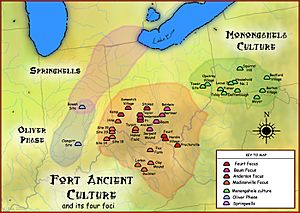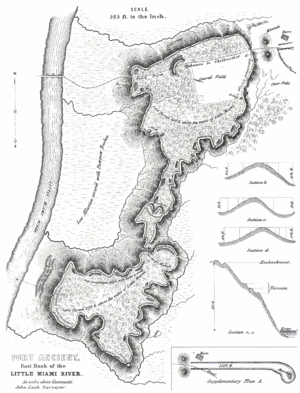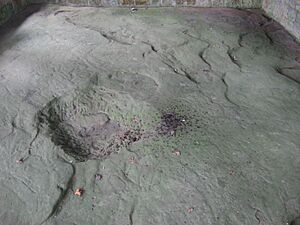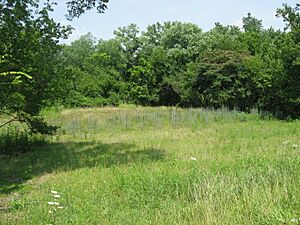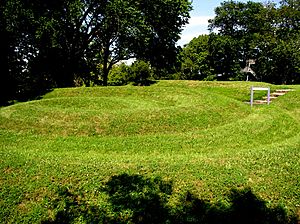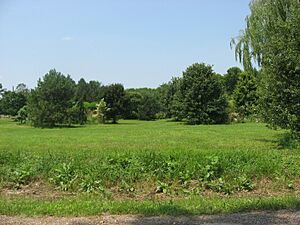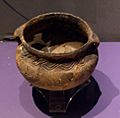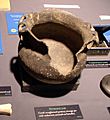Fort Ancient facts for kids
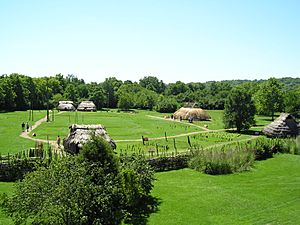
The Fort Ancient culture was a group of Native American people. They lived from about 1000 to 1750 CE. Their homes were mostly near the Ohio River valley. This area is now parts of southern Ohio, northern Kentucky, southeastern Indiana, and western West Virginia.
The Fort Ancient people lived at the same time as the Mississippian culture. They are often seen as a "sister culture." This means they were similar but also different. It is thought that the Fort Ancient people brought corn farming to Ohio. They were also likely the builders of the famous Serpent Mound.
Contents
What's in a Name?
The name "Fort Ancient" comes from a place in Ohio called Fort Ancient. This place is an important archeological site. However, experts now believe that the Hopewell people built the Fort Ancient site. The Fort Ancient culture likely lived there later.
The site is on a hill above the Little Miami River, near Lebanon, Ohio. Even though it's called "Fort Ancient," most archaeologists don't think it was mainly a fort. It was probably a special place for ceremonies.
A Look into the Past: Fort Ancient History
Historians divide the Fort Ancient culture into different time periods. This helps us understand how their way of life changed over hundreds of years.
Early Fort Ancient (1000 to 1200 CE)
Around 1000 CE, people in the Ohio Valley started farming maize (corn). They lived in small villages with about 40 to 50 people. These villages were often along rivers. They would live in one spot for a short time, then move to a new place.
Middle Fort Ancient (1200 to 1400 CE)
By 1200 CE, villages grew larger, with up to 300 people. They stayed in one place for longer, sometimes up to 25 years. Houses were usually for one family. Later, some houses became bigger for multiple families.
Villages were often built around an open, oval-shaped central area called a plaza. Houses faced this plaza. The way buildings were placed might have helped them track the sun's movements, like a calendar. People also started building small platform mounds for ceremonies. Many villages added palisades (strong fences) for protection. The plaza was the heart of village life, used for ceremonies and games.
Late Fort Ancient (1400 to 1750 CE)
From 1400 to 1750 CE, villages became even bigger, with up to 500 people. Archeologists think that after 1450, there might have been more fighting between groups. This led people to live in larger, protected villages.
During this time, the Fort Ancient people had more contact with Mississippian groups. Some Mississippian people might have even moved into Fort Ancient villages. We find Mississippian-style items in Fort Ancient sites from this period.
Later, from 1550 to 1700, people lived in their villages all year. However, fewer people might have stayed in the village during winter. This could mean families went out to hunt in areas their ancestors used. The Fort Ancient people also started getting European trade items like glass, iron, and brass. These items were found at sites even before Europeans arrived in the area.
Although the Fort Ancient people didn't meet Europeans directly at first, they likely suffered from European diseases. These diseases spread through trade networks among Native American groups. The next known people in the area were the Shawnee. Many experts believe the Fort Ancient society was greatly affected by waves of sickness from the first Spanish explorers in the mid-1500s.
After 1525, at the Madisonville site, houses became smaller and fewer. This suggests people relied less on farming and staying in one place. Many scholars think the Shawnee tribe might be linked to the Fort Ancient people.
How Society Changed
The Fort Ancient culture changed a lot over time. It wasn't a single group at first but slowly came together.
Early Phase (around 1000-1250 CE)
In this period, the Fort Ancient people lived in small, simple villages without palisades. They mostly farmed corn, beans, and sunflowers. Sunflowers were first grown for food in Ohio. Most homes were "pit-houses," dug a few feet into the ground with a roof made of bark and wood.
Middle Phase (around 1250-1450 CE)
During this time, the culture became richer and started to grow. Villages got bigger and added palisades. Pit-houses were replaced by rectangular "cabin-style" homes. These homes were made of adobe-like material or wood with peaked roofs.
Other big changes happened too. The Mississippian culture shifted its main areas. Also, Iroquois groups expanded, bringing new neighbors to the Fort Ancient region. The Fort Ancient people started borrowing ideas from other cultures. For example, they combined mound burials with Iroquoian ways of preparing the dead. Mississippian influences came from the south. In western Ohio, they even adopted the Algonquian Green Corn Ceremony. In this ceremony, some corn was burned to help fertilize the fields. Around 1300, mound burials were replaced by burying the dead under homes.
Late Phase (around 1450-1750 CE)
This was the peak of the Fort Ancient culture. Only one Fort Ancient tribe, the Mosopelea, is known by name from historical records. They lived in southeast Ohio. There's also a chance that the Keyauwee, a Siouan people, were related to the Fort Ancient culture.
Even though there are no direct records of Europeans meeting the Fort Ancient people, many European items have been found at their sites. These include brass, steel, and glass. The Fort Ancient people even melted down old metal items to make new ones. No gun parts have been found at their sites.
The Fort Ancient people were heavily affected by European diseases and wars. It seems they died out in waves, not all at once. The latest sites found are from northern Kentucky, dating from 1680 onwards. When French explorers arrived, they saw many similar villages along the Ohio River that were destroyed or abandoned.
Social Life and Leadership
Fort Ancient villages did not have strong central leaders or different social classes like some other cultures. People likely gained respect and status through their actions, like being a good hunter or sharing with others. Leaders probably helped organize trade, settle arguments, and lead ceremonies. Evidence suggests that leaders were buried like everyone else, showing that everyone was seen as equal in death.
Pottery and Tools
Fort Ancient women were usually the pottery makers. They used a method called coiling. They rolled clay into long strips and layered them to shape pots. They smoothed the inside with a stone and the outside with a wooden paddle. Pots were often decorated with patterns.
Early Fort Ancient pottery often used crushed stone or old pottery for strength. Over time, they started using crushed mussel shells more often. This was a technique also used by Mississippian cultures. This change in pottery style spread from the Ohio River north and east.
They made tools from stone, bone, horn, shells, and antlers. They used small, triangular flint arrowheads and large triangular flint knives. Hoes for farming were made from mussel shells. They also made stone axes for cutting trees. Most tools were made from local materials.
What They Ate
The Fort Ancient people were mainly farmers and hunters. Their main foods were the "three sisters:" maize (corn), squash, and beans. They also hunted animals like black bear, turkeys, white-tailed deer, and elk. Some sites suggest they might have kept turkeys in pens.
Studies of their bones show that their average lifespan was shorter than their ancestors'. They were also smaller and had more health problems, like dental disease and arthritis.
Important Fort Ancient Sites
| Site | Image | Description |
|---|---|---|
| Buckner site | A Middle Fort Ancient village in Bourbon County, Kentucky. It has two large circular village areas, each with its own central plaza. | |
| Buffalo Indian Village Site | A site with at least two overlapping Mid to Late Fort Ancient villages (1300 to 1600) near Buffalo, along the Kanawha River. | |
| Cleek–McCabe site | A Middle Fort Ancient site near Walton in Boone County, Kentucky. It includes two mounds and a village. | |
| Clover site | A Late Fort Ancient site (1550 to 1600) near Lesage in Cabell County, West Virginia. | |
| Feurt Mounds and Village Site | A site with three burial mounds and a village in Scioto County, Ohio. | |
| Fort Ancient Site | The largest prehistoric hilltop enclosure in the United States. It has three and a half miles of walls. The Hopewell people built it. Later, a Fort Ancient village and cemetery were built inside. It's in Warren County, Ohio. | |
| Fox Farm site | A Middle Fort Ancient site near Mays Lick in Mason County, Kentucky. It's a large village complex on a ridge near the Licking River. | |
| Hardin Village site | A Late Fort Ancient site near South Shore in Greenup County, Kentucky. It was occupied from the early 1500s to about 1625. It had a defensive palisade but no central plaza. | |
| Hobson site | Located near Middleport, Ohio on the Ohio River. The main part is a Fort Ancient village from 1100 to 1200 CE. | |
| Leo Petroglyph | A sandstone rock carving with 37 images of humans, animals, and footprints. It's near Leo, Ohio in Jackson County, Ohio. | |
| Bentley site | A Fort Ancient site (after 1400) near South Portsmouth in Greenup County, Kentucky. An 18th-century Shawnee village was built on top of it. | |
| Madisonville site | A Fort Ancient site on the banks of the Little Miami River in Mariemont, Ohio. It includes an effigy mound and village remains. | |
| Ronald Watson Gravel site | A Middle Fort Ancient site near Petersburg in Boone County, Kentucky, on a bend of the Ohio River. | |
| Sand Ridge Site | A Late Fort Ancient site located on a ridge west of Cincinnati. | |
| Serpent Mound | The Fort Ancient people built the largest effigy mound (a mound shaped like an animal) in the United States. | |
| SunWatch Indian Village | A recreated Fort Ancient village in Dayton, Ohio. Many discoveries about the Fort Ancient people were made here. | |
| State Line Site | A Middle Fort Ancient group of sites on the Indiana/Ohio border. Pottery found here shows contact with Mississippian cultures. | |
| Thompson site | An Early Fort Ancient site near South Portsmouth, Kentucky, by the Ohio River. | |
| Turpin site | An Early Fort Ancient site near Newtown in Hamilton County, Ohio. It has village remains and burial mounds. |
Neighbors and Other Cultures
The Fort Ancient people lived near other groups. To their northeast were the Monongahela culture people (1050 to 1635). They also farmed corn and lived in palisaded villages. To the northwest were the Oliver phase people in central and southern Indiana (1200 to 1450). Their villages were also circular with palisades.
Some experts believe colder weather during the Little Ice Age might have caused fighting over food. Crops didn't grow as well, leading to food shortages. Some studies suggest the culture declined due to poor health.
These groups were once thought to be Mississippian people moving into new areas. But now, experts believe they developed locally from earlier Woodland peoples.
About 95 kilometers (59 miles) southwest of the Fort Ancient settlements were the Middle Mississippian culture people. The area between them might have been an empty zone. This could be due to social reasons or because the river valley there wasn't as good for farming.
Symbols and Beliefs
Many artifacts found from the Fort Ancient culture have special meanings. Common items include four-handled pots, salamanders, and snakes.
The four-handled pots might be linked to common Siouan religious beliefs. The medicine wheel, a cross inside a circle, has been found on at least one artifact. This symbol means that all life comes from the same place and returns there. The four handles might represent this symbol.
Salamanders might have had two meanings. In some Native American cultures, salamanders represented boys. Or, in Eastern Siouan beliefs, a barking salamander meant someone would die soon. So, salamanders might have been a sign of death or a link between the living and spirit worlds.
The Serpent Mound is another example of symbolism. It is shaped like a constellation (a group of stars) known as the Snake to many Siouan peoples. The mound shows the snake swallowing an egg, which represents fighting against big challenges for the good of the people. Some Siouan people believed stars were a mirror of the spirit world. So, the Serpent Mound might have been a special burial place for honored people, connecting them to the earth and their ancestors.
Images for kids
-
Mississippian Shell gorget from a Fort Ancient site in Ohio, now at the Southern Ohio Museum and Cultural Center in Portsmouth, Ohio
-
Artists conception of the SunWatch Indian Village


